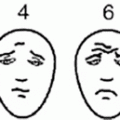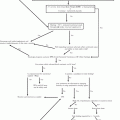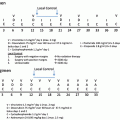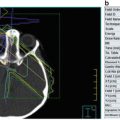• Anemia, manifested by pallor and weakness
• Fever, resulting from infection or leukemia itself
• Hepatosplenomegaly
• Adenopathy
• Petechiae, ecchymosis, epistaxis, gingival bleeding
• Severe hemorrhage or disseminated intravascular coagulation, most common in APL
• Gum infiltration
• Leukemic skin infiltration
• Granulocytic sarcoma or chloroma found in orbital, paranasal sinuses, or paraspinal areas
Diagnosis and Classification
The diagnosis and classification of AML relies on morphologic, cytochemical, immunophenotypic, cytogenetic, and molecular features of the leukemic cells. The presence of Auer rods is a specific but not sensitive marker of AML. Arrangement of Auer rods in bundles (faggot cells) is very suggestive of APL. Cytochemical studies (myeloperoxidase, Sudan Black, nonspecific esterase), immunophenotyping, cytogenetic studies, and molecular studies provide further evidence of the AML subtype and yield information critical to prognosis and selection of risk-adapted therapies.
In LIC, the diagnosis of AML is commonly based on morphology and variably supported by cytochemical and immunophenotypic analysis. For this reason, AML is classified according to the French-American-British (FAB) criteria. Only highly specialized cancer units can perform cytogenetics and molecular biology studies. Lacking the information such studies can offer, many LIC institutions are prevented from implementing optimized therapy based on an accurate characterization of AML subtypes.
The current World Health Organization (WHO) classification of the myeloid neoplasms incorporates morphologic, immunophenotypic, cytogenetic, molecular, and clinical information to reach a final classification (Table 17.2) [3]. The WHO scheme is the standard for uniform characterization of AML and should be used for treatment comparisons among different collaborative groups (Table 17.3).
Table 17.2
Comparison of FAB and WHO classifications of AML
FAB classification | – Classifies into 8 subtypes, from M0 to M7, determined by morphologic, immunophenotypic, and cytogenetic features |
WHO classification | – Incorporates genetic, morphologic/cytochemical, and immunophenotypic information into subtypes of AML with clinical and prognostic relevance |
– Allows the AML diagnosis to be made regardless of the blast cell count in cases associated with specific genetic abnormalities |
Table 17.3
Frequent subtypes of pediatric AML in the WHO classification
• Acute myeloid leukemia with recurrent genetic abnormalities |
– AML with t(8;21) |
– AML with abnormal bone marrow eosinophils and inv(16) |
– APL with t(15;17) (PML/RAR) and variants |
– AML with t(9;11) |
– AML (megakaryoblastic) with t(1;22) |
• Therapy-related myeloid neoplasms |
• Acute myeloid leukemia, not otherwise specified |
– Acute myelomonocytic leukemia |
– Acute monoblastic/monocytic leukemia |
– Acute erythroid leukemia |
– Acute megakaryoblastic leukemia |
• Myeloid sarcoma (Previously known as granulocytic sarcoma or chloroma, it should be considered as AML) |
• Myeloid proliferation related to Down syndrome |
– Transient abnormal myelopoiesis |
– Myeloid leukemia associated with Down syndrome |
(Comprising: transient abnormal myelopoiesis, myelodysplastic syndrome, and myeloid leukemia associated with Down syndrome) |
Treatment of Pediatric AML
Modern treatment of pediatric of AML is similar to that proposed in adult AML protocols. Treatment guidelines have been established for more than 3 decades. Attempts to treat pediatric AML using ALL guidelines were unsuccessful. Improvement in pediatric AML outcome has been essentially a result of improved supportive care, risk-stratification, and effective management of infections, particularly fungal infection. Clinical trials that incorporated these elements, including judicious indications for hematopoietic stem cell transplantation (HSCT), have yielded the best results [4, 5].
In general, complete remission (CR) rates of around 95 % and overall survival (OS) rates of up to 70 % are reported in HIC (Table 17.4) [6–9]. Treatment failures are mainly due to AML relapse and, to a lesser extent, treatment-related mortality (TRM).
Table 17.4
Examples of treatment regimens used in AML
AML-BFM Study Group | Induction: AIE (ARAC+IDA+VP-16) |
AML-BFM 93 [26] | Consolidation: |
High-risk patients: HD-ARAC+ MTZ (HAM) + 6-week consolidation with 6-TG + prednisone + vincristine + doxorubicin + ARAC + cyclophosphamide | |
Standard-risk patients: 6-week consolidation (see above) without HAM | |
Intensification: HD-ARAC + VP-16 (HAE) | |
CNS prophylaxis: Intrathecal ARAC + cranial irradiation | |
HSCT: allogeneic HSCT in high-risk patients if matched related donor is available | |
Maintenance: 6-TG daily + ARAC monthly for a total of 12 months | |
CR 82 %, 5-year OS 57 % | |
Medical Research Council | Induction I: ARAC+DAUNO+VP-16 (ADE) versus MTZ+ARAC+VP-16 (MAE) |
MRC AML12 Trial [8] | Induction II: same as induction I but with ARAC shortened from 10 to 8 days |
Consolidation 1: Amsacrine+ARAC+VP-16 | |
Consolidation 2: HD-ARAC+ l-asparaginase | |
Consolidation 3–4: HD-ARAC+MTZ | |
CNS prophylaxis: Triple intrathecal methotrexate + ARAC+ hydrocortisone | |
HSCT: allogeneic HSCT in standard or poor risk patients with matched related donor available | |
CR 90 %, 10-year OS 61 % | |
NOPHO-AML 93 [7] | Induction I: ARAC+ 6-TG+VP-16+DOXO |
Induction II: same as induction I for good responders, or ARAC+MTZ for poor responders | |
Consolidation 1: HD-ARAC+MTZ | |
Consolidation 2: HD-ARAC+VP-16 | |
Consolidation 3: HD-ARAC | |
Consolidation 4: HD-ARAC+VP-16 | |
CNS prophylaxis: Intrathecal methotrexate | |
HSCT: allogeneic HSCT recommended to all patients with matched family donor | |
CR 92 %, 5-year OS 65 % |
In contrast with the progress made in pediatric AML in HIC, the outcomes in LIC have not improved significantly [10, 11]. Lack of expeditious access to tertiary care centers for opportune diagnosis and treatment, scarcity of resources needed for diagnosis and treatment, disparities between the increase in chemotherapy intensity and the quality of supportive care, and a high prevalence of abandonment of treatment hamper the outcomes (Table 17.5) [10, 12–14]. Furthermore, high mortality rates before or during induction reaching 18 %, with overall TRM higher than 20 %, and relapse reaching 35 % impose additional obstacles to better cure rates [10, 15–17]. All of these factors come together in a scenario where malnutrition is present in more than half of children with cancer [12, 18, 19]. These circumstances along with the high prevalence of severe acute and chronic infections at the time of diagnosis constitute major issues that negatively influence the outcomes of children with AML in LIC [20].
Table 17.5
Principal barriers in treating AML in LIC
• Scant development of local multidisciplinary team and laboratory facilities |
• Insufficient financial support for pediatric oncology units |
• Lack of rapid access to medical facilities |
• Scarce development of supportive care measures, which results in inadequate balance between intensity of chemotherapy and supportive care |
• High rate of abandonment of treatment |
• Lack of information that hinders learning from treatment strategies in LIC that have either succeeded or failed. Few published reports from LIC’s experiences |
For APL, the introduction of therapy with all-trans-retinoic acid (ATRA) and arsenic trioxide (ATO) has been an important breakthrough in reducing the risk of early mortality related to coagulopathy, increasing CR rate, and reducing relapse, thereby improving the outcomes of this subtype of myeloid leukemia. Overall survival in APL is greater than 90 % in HIC, but in LIC the difficulties noted above limit the overall survival of patients [14, 21–23].
Induction Therapy
The main objective in AML treatment is to achieve a complete remission. Complete morphological remission is defined as less than 5 % blast cells in bone marrow (BM) with evidence of normal myelopoiesis recovery, and without extramedullary disease. The use of molecular and immunophenotypic markers has revealed that meaningful remission is achieved after the leukemia burden is less than 0.1 % [24, 25]. An intensive induction schedule is instrumental in achieving the treatment objective.
Currently, the combination of cytarabine and anthracycline with etoposide or thioguanine is considered the mainstay of induction treatment in AML, inducing remission rates of up to 90 % in pediatric patients [8, 26].
Various strategies have been implemented to intensify the induction treatment and are intended to increase the CR rates and positively affect the outcomes. Some examples are increasing cytarabine dosage, utilizing diverse anthracycline drugs, and shortening the intervals between initial cycles of chemotherapy (i.e., intensive timing). However, in some trials higher intensity negatively affected the CR rate because of an increased number of deaths related to toxicity [4], corroborating the importance of an optimal balance between intensive chemotherapy and a supportive care.
Results from earlier studies demonstrated that cytarabine and anthracycline, both used as single agents, were effective in inducing initial CR in at least one third of the patients.
Improvements in CR rates were achieved by increasing the total dosage of chemotherapy drugs during induction, or by shortening the time between the initial blocks of treatment (intensive timing) without increasing the cumulative dose of chemotherapy.
The intensification of cytarabine therapy achieved by increasing the number of cytarabine days resulted in an improvement in CR rate [27–29]. It has been demonstrated that increasing the doses of cytarabine overcomes some resistance mechanisms of leukemic cells [30, 31]. The combination of cytarabine with daunorubicin (DAUNO) (7 days of cytarabine + 3 days of DAUNO) in induction therapy resulted in improved CR and OS rates [27, 29, 32].
An alternative strategy to intensify the induction therapy is the addition of a third drug such as etoposide or purine analogs to the 7 + 3 regimen. This addition resulted in better CR and OS rates; however, no significant evidence of superiority was found when etoposide versus purine analog regimens were compared [33].
Likewise, anthracyclines at higher doses have improved the outcomes in patients with AML, with optimal results related to a cumulative dose of 375–550 mg/m2, when administered in the context of treatment with high-dose cytarabine as postremission therapy [34, 35]. Nevertheless, use of this dose intensification has been limited because of its cardiotoxicity, associated with either high peak serum concentrations or cumulative dosages >300 mg/m2 [36]. To reduce cardiotoxicity it has been proposed to split the daily dose or prolong the infusion of anthracyclines; other options are the use of liposomal anthracyclines or cardioprotectant agents. However, there is concern about a possible higher rate of secondary malignancies in pediatric cancer patients treated with a cardioprotectant [37].
Several different anthracycline drugs have been prospectively evaluated. Idarubicin (IDA), mitoxantrone (MTZ) (an anthracenedione), and other agents have been studied as substitutes for DAUNO, but it appears that no anthracycline agent has any advantage over another in terms of improving the outcome [35, 38].
The Medical Research Council (MRC) AML12 trial compared the efficacy and toxicity during induction therapy of DAUNO and MTZ, each agent in a combination with similar doses of cytarabine and etoposide (ADE regimen versus MAE regimen, respectively). With an approximate dose ratio of 4:1 for daunorubicin:mitoxantrone, no significant difference in CR rate or event-free survival (EFS) was found; additionally, MTZ was associated with increased myelosuppression [8].
IDA is frequently used as part of the induction treatment with a dose ratio of 5:1 for daunorubicin:idarubicin [26]. The Berlin/Frankfurt/Muenster (BFM) Study Group compared the induction with cytarabine, idarubicin, and etoposide (AIE) versus ADE. With the AIE regimen there was better reduction of blast cells in the bone marrow at day 15 in high-risk patients. However, both treatment groups had a similar OS [26]. An additional advantage of IDA is its main metabolite idarubicinol, which has a prolonged plasma half-life and exerts antileukemic activity in the cerebrospinal fluid (CSF) [39].
Doxorubicin appears to increase the incidence of moderate and severe mucosal toxicity: stomatitis and typhlitis were more frequent in patients treated with doxorubicin than with DAUNO [40].
Purine nucleoside analogs such as clofarabine, cladribine, and fludarabine, which were initially tested and found effective in relapsed AML [41–43], have been also incorporated in induction treatment of de novo AML, but their impact on CR rates and OS have not been determined.
The most common induction regimens include cytarabine and anthracycline. A third agent, usually etoposide or purine analogs, is sometimes added to the cytarabine/anthracycline regimen. In settings with limited resources, two courses of induction with cytarabine, an anthracycline, and a third drug, usually etoposide, are used to induce remission. Seven days of cytarabine with 3 days of anthracycline seem to be an adequate and practical schedule in settings with high early mortality rates. For patients with leukocytosis, cytarabine (usually 100 mg/m2 every 12 h for 48–72 h administered intravenously via bolus injection or continuous infusion) can reduce the WBC count and allow for support measures to stabilize patients with concurrent infectious, hemorrhagic, or metabolic complications. Alternatively, hydroxyurea (25–50 mg/kg/day) can be used for the same purpose.
Considering its therapeutic advantages and toxicity profile, DAUNO seems to be better suited for induction in LIC because it is associated with less mucosal toxicity, including mucositis and typhlitis, than doxorubicin.
In LIC, the lack of the optimal supportive care found in HIC prevents the delivery of the second induction treatment in a shorter time interval (i.e., use of an intensive timing strategy). For this reason, the rapid clearance of blasts exerted by IDA likely does not represent a practical advantage that can outweigh the risks associated with intensive timing that are encountered in LIC.
Implementing a three-drug induction strategy (ADE or DAT: DAUNO, cytarabine, 6-thioguanine) requires a careful evaluation of the actual supportive resources that are available locally to assure an optimal balance between intensity of treatment and supportive care. Key issues to define this optimal balance are the magnitude of the early mortality rate and the duration of myelosuppression. High TRM rates represent a negative impact on survival that surpasses the advantages of a three-drug induction regimen.
Postremission: Consolidation Therapy
Postremission therapy is necessary to eradicate any residual disease and prevent relapse in patients with AML. In this regard, different AML cooperative groups have implemented several strategies. Evidence from AML trials has demonstrated that intensification of postremission therapy, with or without HSCT, is an effective strategy to improve outcomes [4, 5, 26, 44]. A number of trials in children and adults demonstrated that postremission therapy with high-dose cytarabine (≤1 g/m2/dose) played a key role in improving the outcome in children with AML [45].
Currently, in most of the pediatric AML trials, the standard consolidation treatment is based on a total of two to five courses of high-dose cytarabine, combined with non-cross-resistant agents similar to what was previously given during the induction [7, 46–48]. However, there is no clear evidence that more than three consolidation courses after two courses of induction leads to better outcomes [8, 49].
The combination of high-dose cytarabine with mitoxantrone (HAM) when given as a consolidation block may provide the advantage of enhancing the cytotoxic activity by introducing a non-cross-resistant agent (mitoxantrone) [26].
The use of etoposide as part of the postremission intensification strategy has contributed to the improvement of outcomes in AML [50]. Treatment with HSCT as a consolidation strategy has been studied, but recommendations for HSCT in first CR remain controversial [34, 51]. There is evidence that HSCT improves the outcomes in children with high-risk AML but not in those with favorable cytogenetic findings [25, 26, 52–54].
A meta-analysis found no benefit in relapse rate and OS for autologous HSCT versus chemotherapy alone. Additionally, it appears that there is an increased risk of death during first remission for patients treated with autologous HSCT. Consequently, autologous HSCT should not be recommended as the first-line postremission therapy for AML children in first CR (CR1) [55].
Data from MRC showed that allogeneic HSCT in CR1 failed to show a survival advantage because of an increase in procedure-related deaths. Furthermore, autologous HSCT did not improve the long-term survival, not because of increased procedure-related deaths, but because of inferior survival after relapse [8]. Therefore, accurately diagnosing patients who have predictors of poor response to chemotherapy can be benefited by allogeneic HSCT in CR1.
CNS-Directed Therapy
The incidence of central nervous system (CNS) leukemia in pediatric AML at the time of diagnosis ranges from 3 to 30 % [35, 51, 57]. CNS leukemia is associated with young age, hyperleukocytosis/leukostasis, monocytic leukemia (FAB M4 or M5) including acute myelomonocytic leukemia with bone marrow eosinophilia (M4eo) with inv(16), and MLL gene rearrangement [51, 57].
Previously, for AML patients without CNS involvement, the CNS prophylaxis was either single or triple intrathecal drug delivery, given alone or combined with cranial irradiation. Currently, there is evidence that treatment with repeated courses of intensive chemotherapy combined with intrathecal therapy, even omitting cranial irradiation, may prevent CNS relapse [51]. Furthermore, in the context of intensive treatment comprising high-dose cytarabine, which crosses the blood–brain barrier, CNS leukemic infiltration at diagnosis is not an adverse prognostic factor, and these patients can be cured without cranial irradiation [51, 58, 59]. Therefore, at present, most clinical trials have abandoned the cranial irradiation, even for patients who presented with CNS involvement [47, 48, 60]. An additional reason to omit cranial irradiation is its late sequelae, including secondary malignancies [61, 62]. The BFM Study Group, however, continues using cranial irradiation because of the reduction in systemic relapses observed in patients receiving CNS irradiation in their studies [26].
At relapse, the incidence of CNS involvement appeared to be less in patients who received CNS prophylaxis as part of the initial treatment than in those who did not [63].
There are no data comparing the efficacy of single drug (either methotrexate or cytarabine) versus triple drug (methotrexate, cytarabine, and hydrocortisone) intrathecal therapy. However, evidence from clinical trials revealed that the triple intrathecal regimen is associated with low rates of CNS leukemia relapse [8, 51, 60]. Currently, CNS prophylaxis with single or triple intrathecal chemotherapy at age-adjusted doses is commonly used for most pediatric clinical trials. Total doses range from 4 to 12, but the optimal number remains unknown [4, 57].
It appears that in pediatric AML a small number of blasts in the CSF (CNS-2 status) do not represent a risk factor for CNS relapse in patients treated with intensive chemotherapy [58, 59]. Moreover, there is evidence that in the context of intensive chemotherapy combined with intrathecal treatment, CNS positive status (CNS-3 status) at the time of diagnosis does not affect OS [58, 59]. Patients with CNS3 status require intensified CNS-directed therapy. The accepted treatment approach is to administer weekly intrathecal therapy until the CSF is clear of leukemic cells, not less than four doses, and then monthly doses until the end of therapy, without cranial irradiation [8, 57, 59, 60].
Acute Promyelocytic Leukemia in Children
APL is a particular subtype of AML with distinct clinical features, genetic abnormality, and excellent outcomes when treated appropriately. In many series, APL constitutes 5–10 % of childhood AML [8, 46, 48] with a higher incidence in some ethnic groups as reported in Hispanic and Mediterranean populations [2, 64–67].
APL is characterized by an increased risk of life-threatening hemorrhagic complications, an abnormal promyelocytes morphology (M3 FAB) strongly associated with the t(15;17), and a high sensitivity to ATRA and ATO that leads to favorable outcomes.
APL is a medical emergency because of the increased risk of life-threatening hemorrhagic complications occurring at the time of diagnosis or during the initial treatment. The risk of early hemorrhagic death, mainly intracranial hemorrhage, is higher in patients with WBC count >10 × 109/L and with the M3 variant morphology [4].
Commonly, the diagnosis of APL has been based on the leukemic cells morphology complemented with the confirmatory demonstration of the t(15;17).
The FAB morphological classification describes two subtypes of APL: the classical M3 form (M3-AML) and the hypogranular or microgranular variant form (M3v-AML). The M3-AML form is characterized by hypergranular promyelocytes with heavy azurophilic granules, bundles of Auer rods (faggot cells), and bilobed nuclei. By contrast, in the M3v-AML form, the majority of blast cells have bilobed, multilobed, or reniform nuclei, with few or no azurophilic granules; still, in M3v-AML at least a few cells with features of classical M3-AML morphology can be found [4, 68].
A characteristic, but not diagnostic, immunophenotypic profile has been described, namely, the consistent expression of CD117 and the lack of CD34 and HLA-DR expression. The presence of these findings, in the context of myeloperoxidase-positive blast cells, and myeloid antigen expression as CD13 and/or CD33 make APL diagnosis possible [69].
Cytogenetics and molecular analysis identify either APL with the classical t(15;17) or the variant forms; also molecular methods allow subsequent molecular minimal residual disease (MRD) monitoring.
In the current WHO classification, APL is classified in the subgroup of AML with recurrent genetic abnormalities (see Table 17.3). According to this classification, the demonstration of the t(15;17) is sufficient for the diagnosis of AML, regardless of the blast cell percentage in peripheral blood (PB) or BM [3]. The WHO classification also recognizes three RARalpha variant translocations, two of them with t(11;17), and one with t(5;17). Each of these variants has a different response to ATRA, with t(11;17) being the most resistant to this treatment [3, 70].
The therapy with ATRA should be initiated immediately in children with leukemia presenting with peripheral blood blasts with APL cell morphology.
Currently, up to 80 % of children with APL are cured when their treatment protocol combines ATRA and anthracycline (Table 17.6) [71–74]. The unique sensitivity of APL blast cells to ATRA and to ATO has contributed to the achievement of CR rates around 95 % by reducing the risk of early mortality related to hemorrhagic disorders. ATRA induces the differentiation of the leukemic blasts into mature granulocytes and consequently induces apoptosis without acute lyses of the leukemic blasts, thus preventing the release of fibrinolytic and procoagulant factors from the cytoplasmic granules of the leukemic promyelocytes.
Table 17.6
Examples of treatment regimens used in APL
GIMEMA | Induction: ATRA+IDA (AIDA regimen) |
APL-AIDA 2000 [99] | Consolidation: 3 monthly courses |
High-risk patients: HD-ARAC+IDA+ATRA (course 1); MTZ+VP-16+ATRA (course 2); ARAC+IDA+6-TG+ATRA (course 3) | |
Low-/intermediate-risk patients: omitting ARAC from courses 1 and 3, and omitting VP-16 from course 2 | |
CNS prophylaxis: methotrexate + methylprednisolone before each consolidation cycle | |
Maintenance: low-dose chemotherapy with 6-MP+methotrexate; alternating with ATRA for 15 days every 3 months, during 2 years | |
CR 94 %, 6-year OS 87 % | |
PETHEMA | Induction: ATRA+IDA (AIDA regimen) |
LPA 2005 [21] | Consolidation: 3 monthly courses |
High-risk patients: HD-ARAC+IDA+ATRA (course 1); MTZ+ATRA (course 2); ARAC+IDA+ATRA (course 3) | |
Low-/intermediate-risk patients: omitting ARAC from courses 1 and 3, and reducing dose of MTZ | |
CNS prophylaxis: not given | |
Maintenance: low-dose chemotherapy with 6-MP+methotrexate; alternating with ATRA for 15 days every 3 months, during 2 years | |
CR 92 %, 4-year OS 88 % | |
AML-BFM Study Group | Induction: ATRA+AIE (ARAC+IDA+VP-16) |
AML-BFM 2004 for APL [79] | Consolidation: 3 courses: intermediate-dose ARAC+IDA (course 1); intermediate dose ARAC+MTZ (course 2); HD-ARAC+VP-16 (course 3) |
CNS prophylaxis: Intrathecal ARAC (in a total of 11) + cranial irradiation | |
Maintenance: low-dose chemotherapy with 6-TG+ARAC; alternating with ATRA for 15 days every 3 months during 18 months | |
CR 94 %, 5-year OS 94 % |








